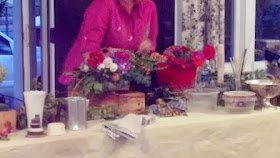I went out to the chicken pen and it looks like a fox or something got one or more of my chickens. There were feathers everyplace inside their hen house and along the fence where the wind had blow them. After counting chicken heads and looking at them closely, I realized that it wasn't a fox, but it is molting season.
 Chicken molt once a year and it takes around 4-8 weeks for the process to take place depending on their breed. They gradually loose their feathers and grow new ones. Molting can be a very stressful and energy intensive time for chickens. One important thing that I keep an eye on is bleeding.
Chicken molt once a year and it takes around 4-8 weeks for the process to take place depending on their breed. They gradually loose their feathers and grow new ones. Molting can be a very stressful and energy intensive time for chickens. One important thing that I keep an eye on is bleeding.
Chickens may occationally, peck on a fello chickens spot that looks a little red. That is their nature and they keep pecking and pecking that other birds spot until it starts to bleed. That hen needs to be isolated immediately until the wound has heeled and feather have started to grow back.
Most chickens stop laying eggs during the molting period or the production is very low. I have read that during this time it helps to provide extra protein to their diets during molting time as feathers are 85% protein. No more than 16-24% of added protein should be added to their diet.
Alfalfa Hay, Sunflower Seed, Cooked Eggs, Peas or Beans, Pearl Millet, or dry Cat Food {not dog food which is high in grains compared to cat food's protein coming from animal protein} are ways to add the protein. We recently disked our fields so I have let my chickens out to forage all those yummy bugs to add extra protein.
Over the many years that I have raised chickens, molting time is when I will normally have my old chickens die, sad to say. The weather is changing getting colder at night; the stress on their bodies of molting and their age is what does it but most of my chickens lead a wonderful life of free ranging, fresh scraps from the gardens, good grains and very little stress of wild animals getting into their hen house. Most of my old hens live to be 7-8 years old. I don't care that they may not lay eggs any longer, it is nice to have them around and being the "seniors" with the other younger chickens. The older girls seem to keep the law and order with the others and teach the pullets how to forage; are the ones who alert the flock when a hawk flys over; and teaches the pecking order of who sleeps where in the hen house at night.
Just when you think they couldn't loose any more feathers, they are all fluffy and covered all over again and the eggs start appearing in their nesting boxes.
We delivered our last Fall Harvest CSA basket this week. In the basket were Hachiya and Fuyu persimmons; pomegranates; kiwi; onions; Granny Smith and Fuji apples; walnuts; 3 colors of bell peppers; banana peppers; green and red tomatoes; cherry tomatoes; Egg plant; mini guavas; Meyer lemons; and baked goods.
It was a full and rewarding farming year and we are so thankful for our wonderful CSA members and other customers that come and buy our produce. And we are thankful to all those people out there in blog land and Facebook land that hear about what we do and lend their comments and support even though they may be states or even countries away from our little farm here in Gridley.
Until next time-


































